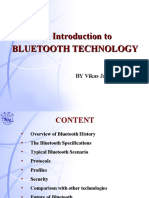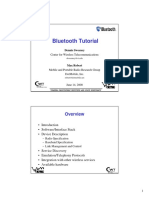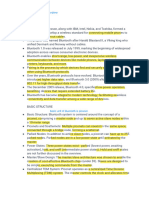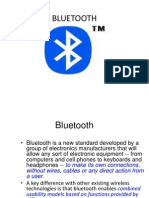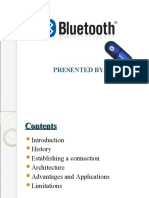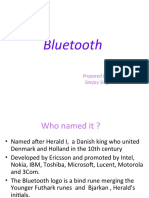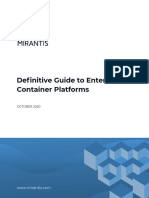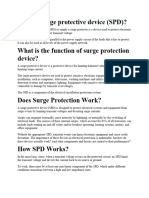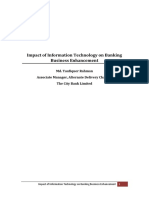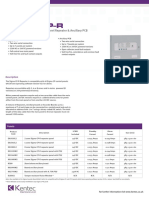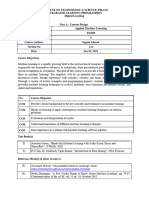Dominique Chomienne & Michel Eftimakis
NewLogic
Bluetooth is a trademark owned by the Bluetooth
SIG, and licenced to NewLogic
Page 1
� Tutorial Agenda
• Bluetooth Marketing view
• Bluetooth network topology
• Bluetooth protocol
• RF
• Baseband
• LC, LM
• HCI
• L2CAP
• Higher layers
• Bluetooth implementation
• Bluetooth “live” demo !!!
Tutorial
Page 2
� Marketing View
Marketing slides ahead
Tutorial
Page 3
�The Last Ten Meters
Page 4
� Systems
Landline
Cable
Replacement
Data/Voice
Access
Points
Personal Ad-hoc
Networks
Page 5
� Target products
Intelligent
Intelligent Devices
Devices Audio
Audio Peripherals
Peripherals
• PCs • Headsets
• Cellular Phones • Speakers
• PDAs • Stereo Receiver
Data
Data Peripherals
Peripherals Embedded
Embedded Applications
Applications
• Mice • Cars: Power lock controls
• Keyboards • Grocery store updates
• Joysticks • Closed Systems
• Cameras • Industrial systems
• Digital Pens • MIDI musical instruments
• Printers
• LAN access points
Page 6
� Usage Models
• Computer to Computer File Transfer
• Dialup Networking
• Synchronization
• 3 in 1 Phone
• Ultimate Headset
• Computer Speakerphone
• Cordless Computer
• Instant Postcard
• Hidden Computing
• Conference Table
• …
Page 7
� Characteristics
• Unlicensed 2.4GHz radio band
• ISM (industrial, scientific,medical) band - Available worldwide
• Also used by Microwave ovens, 802.11, HomeRF…
• Gross data rate of 1 Mbit/s
• Basic 10m range extended to 100m with amplifiers
• TDMA - TDD - Frequency hopping
• Mixed voice / data paths
• Encryption
• Low power
• Low cost
• Extremely small
• Ubiquitous radio link
Page 8
� Market Projections
6000
5000
4000
3000
2000
1000
2001E
2002E
2003E
2004E
2005E
2006E
2001E 2002E 2003E 2004E 2005E 2006E
Total Bluetooth Chipsets (in millions) 48,1 207,7 492,1 921,1 1477 2216
Average Price Per Chipset (in millions of $) 8,50 5,10 4,08 3,26 2,68 2,28
Bluetooth Chip Market Revenue (in millions of $) 409 1059 2008 3006 3953 5042
Source: Merrill Lynch
Page 9
� Who is Bluetooth?
• Harald Blaatand “Bluetooth” II
• King of Denmark 940-981
• Son of Gorm the Old (King of
Denmark) and Thyra Danebod
(daughter of King Ethelred of
England)
• This is one of two Runic stones
erected in his capital city of
Jelling (central Jutland)
• This is the front of the stone
depicting the chivalry of
Harald
• Harald controlled Denmark
and Norway
• Harald thinks mobile PCs and
cellular phones should
seamlessly communicate
Page 10
�Network Topology
Tutorial
Page 11
� Piconet - 1
Unit B
Unit C
Unit H
Unit A
Unit F
Unit D
Unit G Unit E
Page 12
� Piconet - 2
• A piconet is characterized by the master
• Frequency hopping scheme
• Access code
• Timing synchronization
• Master determines the bit rate allocated to each slave
• Slaves do not synchronize to the master
• Calculate offsets to master’s Bluetooth clock
• Monitor timing drift
Page 13
� Piconet - 3
• Only one master
• Dynamically selected
• Roles can be switched
• Up to 7 active slaves
• Active piconet
• Up to 255 parked slaves
• Can be reactivated quickly
• No central network structure
• “Ad-hoc” network
Page 14
� Scatternet - 1
Piconet C
Piconet A
Master A
Master C
Piconet B
Master B
Page 15
� Scatternet - 2
Piconet C
Piconet A
Master A
Master C
Piconet B
Master B
Page 16
� Scatternet - 3
• Interconnected piconets
• One master per piconet
• Few devices shared between piconets
• Master/Slave
• Slave/Slave
• Need special features
• No central network structure
• “Ad-hoc” network
Page 17
� Scatternet applications
• Roaming between access points
Network
AP AP
Mobile
• Data exchange across piconets
Mouse Mouse
PC PC
Printer
Keyboard
Headset
Page 18
�Protocol
Tutorial
Page 19
� Generalities on protocol stack
API
OBEX
7 Application
RFCOMM SDP TCS
6 Presentation
5 Session L2CAP
4 Transport
3 Network HCI
2 Data link Link Manager
1 Physical Link Controller
ISO OSI Layers
Baseband
Radio
Page 20
� Radio - 1
• Unlicensed 2.4GHz radio band
• ISM (industrial, scientific,medical) band
• Also used by Microwave ovens, 802.11, HomeRF…
• Fast frequency hopping
• 1600 (or 3200) hops/s
• 79 frequencies
• 1 MHz spacing
• 220 µs switching time
79 frequency channels
Frequency
(in MHz)
2402 2480
Page 21
� Radio - 2
• Basic 10m range (with 0 dBm radio)
• Extended 100m range (20 dBm)
• Power classes
• Class 1
• Maximum output power: 100 mW (20 dBm)
• Minimum output power: 1 mW (0 dBm)
• Class 2
• Maximum output power: 2.5 mW (4 dBm)
• Minimum output power: 0.25 mW (-6 dBm)
• Class 3
• Maximum output power: 1 mW (0 dBm)
• RSSI-based power control
Page 22
� Baseband - 1
• TDMA – Time division multiple access
• TDD – Time division duplex
Bluetooth frame
Packet
f(2k) f(2k+1) f(2k+2)
master
t
slave
t
625 µs
Page 23
� Baseband - 2
• Multi-slot Packets
625 µs
f(k) f(k+1) f(k+2) f(k+3) f(k+4) f(k+5)
f(k) f(k+3) f(k+4) f(k+5)
f(k) f(k+5)
Page 24
� Baseband - 3
SCO SCO SCO SCO
Master
Slave 1
Slave 2
Slave 3
Page 25
� Baseband - 4
• Packet format
Access code Packet Hdr Payload
• Packet types
• HV1, HV2, HV3 - Voice packets
• DV - Mixed voice/data
• DM1, DM3, DM5 - Protected data packets
• AUX1, DH1, DH3, DH5 - Unprotected data packets
• NULL, POLL, ID, FHS - Baseband control packets
Page 26
� Baseband - 5
• Data rates
Packet Symmetric Asymmetric
FEC
type max rate (kb/s) max rate (kb/s)
DM1 2/3 108.8 108.8 108.8
DH1 no 172.8 172.8 172.8
DM3 2/3 258.1 387.2 54.4
DH3 no 390.4 585.6 86.4
DM5 2/3 286.7 477.8 36.3
DH5 no 433.9 723.2 57.6
AUX1 no 185.6 185.6 185.6
Page 27
� Baseband - 6
• Data error protection
data redundancy
• FEC (Forward Error Correction)
• 1/3 FEC - Repeat each bit 3 times
• 2/3 FEC - (15,10) shortened Hamming code
• ARQ (Automatic Repeat Request)
• Unnumbered
• CRC (Cyclic Redundancy Check)
• HEC (Header Error Check)
• Payload CRC
• Encryption
• Whitening
Page 28
� Baseband - 7
• Bluetooth native clock
• 3.2 kHz (312.5 µs period) - 25 ppm
• 28-bit free running counter (~ 1 day period)
• Never resynchronized
• Estimated clock for paging slave 2
slave 1
• Piconet clock
• Native clock of the master
• Slaves maintain a relative offset to their master
native clocks
• Drift compensation necessary
slave 4
slave 3
Page 29
� Baseband - 8
• Scatternet case
• Master/Slave units use 1 offset
• Slave/Slave units use 2 offsets
X Y
SLAVE Ay
SLAVE Ax
SLAVE By
SLAVE Cxy
MASTER X native MASTER Y
offset y
offset x
SLAVE Bx SLAVE Dy
Page 30
� Link Controller - 1
• Standby
• Device powered on
• Inquiry Standby
• Discover devices in the area
• Collect addresses
• Page
• Connect to a specific device Inquiry Page
Inquiry Page
Scan Scan
• Inquiry scan
• Discoverable state Slave
• Page scan
• Device waiting to join a piconet Connection Master
• Connection
• Actively on a piconet
• Master or slave
Page 31
� Link Controller - 2
• Modes in connection state
• Active
• Maximum 7 slaves
• Sniff
• Low-power active mode
• Hold
• One-time interval
• Park
• Virtually unlimited number of slaves
• Beacon
• Broadcast communication
Page 32
� Link Controller - 3
• Synchronous Connection-Oriented (SCO) Link
• Circuit switching
• Symmetric, synchronous services
• Slot reservation at fixed intervals
• Asynchronous Connection-Less (ACL) Link
• Packet switching
• (A)symmetric, asynchronous services
• Polling access scheme
Page 33
� Link Controller - 4
• Logical channels
• Control channels:
• LC link control
• LM link manager
• Traffic channels:
• US synchronous user data
• UA asynchronous user data
• UI isochronous user data
• Channel mapping
• Packet header:
• LC
• Packet payload:
• LM, US, UA, UI
Page 34
� Link Manager - 1
• Link Manager: Higher Layers
• Closely Related to
Link Controller L2CAP Voice
• No Real-time Functions HCI
Control User
Data
LMP Link Manager
Link Controller
Radio Frequency
Page 35
� Link Manager - 2
• Piconet management
• Attach and detach slaves
• Master-slave switch
• Establishing ACL and SCO links
• Handling of low power modes: Hold, Sniff, Park
• Link configuration
• Supported features
• Quality of Service, usable packet types
• Power Control
• Security management
• Authentication
• Encryption including key management
Page 36
� Link Manager - 3
• ACL Link Setup and Removal
BasebandConnection
Baseband Connection
Authentication//Pairing
Authentication Pairing (optional)
(optional)
EncryptionSetup
Encryption Setup(optional)
(optional)
Master
Master
Slave
Slave
ExchangeSupported
Exchange SupportedFeatures
Features
SetACL
Set ACLLink
LinkParameters
Parameters
Traffic
Detach
Detach
Page 37
� Link Manager - 4
• SCO Link Setup and Removal
• Setup Negotiation
1. Master-initiated 2. Slave-initiated
Request Request
LMP_sco_req
Master
Slave
LMP_sco_req LMP_sco_req
Master
Slave
LMP_sco_req
Possibly other
Master
Slave
Master
LMP_accepted**
Slave
LMP_accepted
Parameters
LMP_sco_req
LMP_sco_req
LMP_accepted**
LMP_accepted
* or LMP_not_accepted
Page 38
� Link Manager - 5
• Link Information Commands
Requesting information • LMP Version
on Remote Device • Supported Features
• Packet Types
• Low Power Modes
LM
LM
Requesting LM
• Master-Slave Switch
AnsweringLM
Request • Power Control
Request
Requesting
Answering
• SCO Air Mode Parameters
• L2CAP
• Encryption
Reply
Reply • Timing Accuracy
• Clock Offset
• Name of Device
Page 39
� Link Manager - 6
• Security (1): Authentication
• Challenge Response Scheme (ISO/IEC 9798-2)
• 32 Bit - Authentication Code (MAC)
• Authentication of Master, Slave or both
Verifier Claimant
Random No. LMP_au_rand
LMP_au_rand
MAC
Address_B
MAC
Address_B Key
Key LMP_sres
LMP_sres
Compare ?
Page 40
� Link Manager - 7
• Security (2): Pairing
• Authentication requires a common secret key
• Pairing includes:
• Generation of Initialization Key
• Generation of Link Key
• Mutual Authentication
KKinit (LMP_in_rand)
init(LMP_in_rand)
Master
Master
Slave
Slave
LinkKey
Link KUnit
Key: :K KComb
orK
Unitor Comb
MutualAuthentication
Mutual Authentication
Page 41
� Link Manager - 8
• Security (3): Encryption 1. Encryption Mode
• Prerequisites
• Successful authentication
(at least one direction) 2. Key Size
• Common Link Key available
• Negotiation in 3 Steps:
Master
• Using encryption
Master
Slave
Slave
• (Point-to-Point / Broadcast)
3. Start Encryption
• Key size:
• Regulations may occur
• Negotiation based on
preferred and allowed key
length EncryptedTraffic
Encrypted Traffic
• Start encryption
4. Stop Encryption
Page 42
� Link Manager - 9
• Security (4): Key Generation
• Options for Keys
• Unit Key from Master or Slave
• Combination Key: calculated from random numbers (secure
exchange)
• Temporary Key
• Temporary and combination keys can be changed at any time
Page 43
� L2CAP - 1
What is L2CAP?
Applications
TCS SDP RFCOMM
ol
ntr
Data Co
L2CAP
Audio LMP
LMP
Link Manager
Baseband
RF
Page 44
� L2CAP - 2
• Logical Link Control and adaptation Protocol (L2CAP)
• Protocol Multiplexing
• Goal: Pass packets used by a particular network protocol to
the appropriate handler
• Segmentation and Reassembly (SAR)
• Goal: Hide data link packet lengths from network-layer
protocols
• Quality of Service
• Goal: Negotiate and enforce QoS contracts
Page 45
� L2CAP - 3
• Protocol Architecture
• Connection-oriented
• Channel identifier used to label each connection
• Channel is assumed to be full-duplex
• QoS flow specification assigned to each channel direction
• Datagram-based, no Streams
• Packet boundaries are preserved
• L2CAP does NOT perform retransmission
• L2CAP does NOT perform Flow Control
Page 46
� L2CAP - 4
• L2CAP Packet Format
Length DCID Payload
(16 bits) (16 bits) (0-65535 bytes)
• Length
• Specifies the length of the payload in bytes
• Destination Channel ID (DCID)
• Identifies the channel to which the packet will be delivered
• Payload
• Data received from and sent to the network layer
• Maximum transmission unit (MTU) limits payload sizes
Page 47
� L2CAP - 5
• L2CAP Channel Establishment
LinkManager
Link ManagerConnection
Connection
L2CAP_CONNECTION_REQUEST
L2CAP_CONNECTION_REQUEST
L2CAP_CONNECTION_RESPONSE
L2CAP_CONNECTION_RESPONSE
Device BB
Device AA
L2CAP_CONFIGURATION_REQUEST
Device
L2CAP_CONFIGURATION_REQUEST
Device
L2CAP_CONFIGURATION
CONFIGURATION_RESPONSE
_RESPONSE
L2CAP_
L2CAP_CONFIGURATION_REQUEST
L2CAP_CONFIGURATION_REQUEST
L2CAP_CONFIGURATION
CONFIGURATION_RESPONSE
_RESPONSE
L2CAP_
Traffic
Traffic
Page 48
� L2CAP - 6
• Segmentation and Reassembly (SAR)
• Use logical channel information from Baseband
• LCH=10 implies start of an L2CAP packet
• LCH=01 implies continuation of L2CAP packet
L2CAP packet
L2CAP Header L2CAP Payload
Baseband packet
Access Code Header Payload
(72) (54) Header
Payload
Page 49
� L2CAP - 7
• SAR Example
Source Destination
Datagram Datagram
L2CAP Packet L2CAP Packet
f1 f2 f3 f4 f1 f2
DH5 DH1 DH5 DH1 DH5 DH1 DH5 DH1
Page 50
� SDP - 1
Service Discovery Protocol
Applications
TCS SDP RFCOMM
ol
ntr
Data
Co
L2CAP
Audio LMP
LMP
Link Manager
Baseband
RF
Page 51
� SDP - 2
• Protocol Architecture
• Connectionless - Client/Server
• SDP defines How services are represented in the DB
• Server database describes all the services available on a device
(Service records)
• SDP defines How to access to the server DB information
Page 52
� SDP - 3
• SDP Client/Server Model
• Transaction identifier used to label each SDP transaction
Client Application Server Application
SDPRequest
Request
SDP
SDP SDP
Client SDPResponse
Response Server
SDP
• Protocol Data Unit Format
PDU id Transaction Id Parameter Length Parameter 1-N
(1 bytes) (1 bytes) (2 bytes) (Parameter Length bytes)
Page 53
� SDP - 4
• Service Discovery
• Searching for Services
• What are the Services provided by the remote device ?
• IrDA-like printer
• Headset
• AudioGateway
• …
• Browsing for Services
• What are the Service Attributes ?
• e.g. : ( L2CAP, PSM=RFCOMM ), ( RFCOMM, CN=1 ), (
PostscriptStream)
• Accessing to the Services (not in the scope of SDP)
Page 54
� Applications - 1
APPLICATIONS
CTP TCP/IP
Voice HP SPP OBEX PPP
Data
Data
l
rt o
TCS SDP RFCOMM n
Co
Data
L2CAP
Audio
Link Manager
Baseband
RF
Page 55
� Applications - 2
• CTP : Cordless Telephony Profile
• HP : Headset Profile
• SPP : Serial Port Profile
• PPP : Point To Point Protocol
• OBEX : Object Exchange Protocol
Page 56
�Implementation
Tutorial
Page 57
� Implementation choices
• Trade-offs (Flexibility, cost, performance, size, power consumption)
Bluetooth module Bluetooth IP + Bluetooth RF
Proc Application
Application ASIC
ASIC
BB BB
ROM/ ROM/
RF Flash RF Flash
Bluetooth single chip Bluetooth IP + RF IP
Application
Application ASIC
ASIC
RF RF BB
BB
ROM/ ROM/
Proc Flash Flash
Page 58
� Integration example
• BOOST integrated approach
• Bluetooth radio
• Bluetooth baseband core
• Bluetooth software stack
Radio Core
ASIC / ASSP
Processor
Application
ROM / Logic
Software RAM
Flash
Page 59
�Live Demo
Tutorial
Page 60
�References
Tutorial
Page 61
� References
• http://www.bluetooth.com - Bluetooth specifications online
• http://www.newlogic.com
• Books:
• Bluetooth: Connect without Cables - Jennifer Bray & Charles Sturman
• Bluetooth Revealed: The Insider's Guide to an Open Specification for
Global Wireless Communications - Brent A. Miller,Chatschik Bisdikian
Page 62



